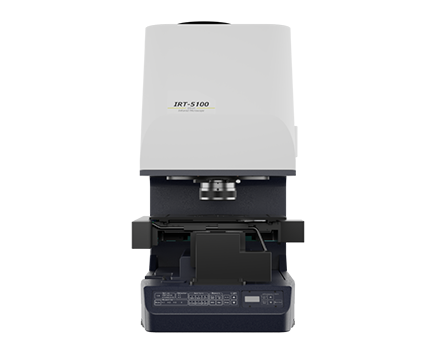Thickness Analysis of Natural Oxide Films using a MSV-5000 Microscopic Spectrophotometer
January 5, 2024
Introduction
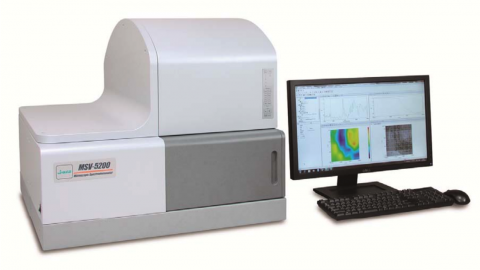
UV-Visible/NIR Microscopic
Spectrophotometer
The MSV-5000 series microscopic spectrophotometer is for transmission and reflection measurements in a wide wavelength range from the ultraviolet to near infrared. The built-in high resolution camera enables sample areas as small as 10 μm in diameter to be precisely measured and therefore is most suitable for samples having microstructure.
In this application note, a sample with silicon patterns 35 μm wide are lined up on a titanium substrate with 14 μm intervals. As silicon is oxidized in air, SiO2 films are formed and the thickness of these films is analysed after obtaining the reflectance spectrum.
Experimental
| Measurement Conditions | |||
| UV-Vis Bandwidth | 5 nm | NIR Bandwidth | 20 nm |
| Response | Slow | Scan Speed | 100 nm/min |
| Data Interval | 0.5 nm | Cassegrain Objective | 16x |
| Incidence Angle | 23° | IN/OUT Aperture | 10 μmΦ |
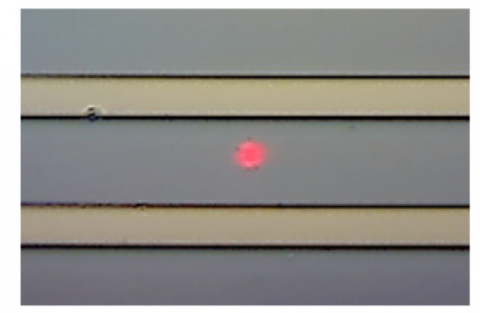
An aluminum vapor-deposited mirror is used as a reference for the baseline measurement. The high-resolution camera is used to determine the sample area (Figure 1). The red spot illustrates the size and position of the detected light. The sample reflectance spectrum is measured and the absolute reflectance spectrum is calculated by multiplying the obtained relative reflectance by the absolute reflectance of the aluminum mirror.
Keywords
220-UV-0021, MSV-5200 microscopic spectrophotometer, VWML-791 Multi-Layer analysis program, Materials
Results
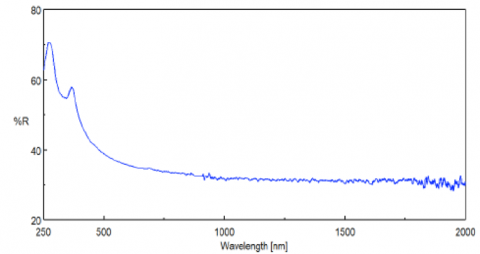
The measured absolute reflectance spectrum is shown in Figure 2. The MSV-5000 series adopts the confocal optical system that eliminates the influence of back side reflection when obtaining a sample measurement. Therefore, above 1100 nm where light passes through silicon, the spectrum is not influenced by back side reflection.
The results of fitting the absolute reflectance spectra using the Multi-Layer Analysis program is shown in Figure 3. The error between the measured and calculated spectrum was within 2% and the film thickness of SiO2 was calculated to be 7.6 nm. The reflectance (R) is expressed using the refractive index of the film (ni), extinction coefficient (ki), the angle of incidence (Φi), wavelength (λ), and the film thickness (di). The optical constants of Si and SiO2 were obtained from the literature values and the film thickness of SiO2 is estimated using the Multi-Layer Analysis program which fits the calculated reflectance spectrum to the measured spectrum.
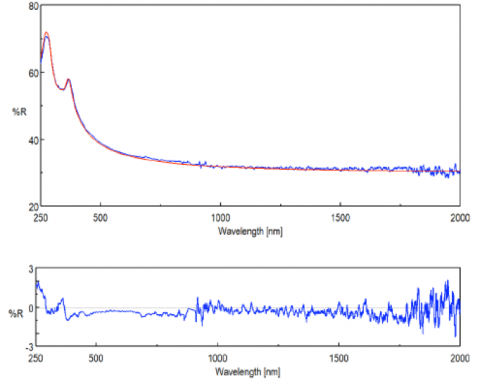
Bottom: Error between the measured and calculated spectra.
Featured Products:

Thickness Analysis of Natural Oxide Films using a MSV-5000 Microscopic Spectrophotometer
Introduction

UV-Visible/NIR Microscopic
Spectrophotometer
The MSV-5000 series microscopic spectrophotometer is for transmission and reflection measurements in a wide wavelength range from the ultraviolet to near infrared. The built-in high resolution camera enables sample areas as small as 10 μm in diameter to be precisely measured and therefore is most suitable for samples having microstructure.
In this application note, a sample with silicon patterns 35 μm wide are lined up on a titanium substrate with 14 μm intervals. As silicon is oxidized in air, SiO2 films are formed and the thickness of these films is analysed after obtaining the reflectance spectrum.
Experimental
| Measurement Conditions | |||
| UV-Vis Bandwidth | 5 nm | NIR Bandwidth | 20 nm |
| Response | Slow | Scan Speed | 100 nm/min |
| Data Interval | 0.5 nm | Cassegrain Objective | 16x |
| Incidence Angle | 23° | IN/OUT Aperture | 10 μmΦ |

An aluminum vapor-deposited mirror is used as a reference for the baseline measurement. The high-resolution camera is used to determine the sample area (Figure 1). The red spot illustrates the size and position of the detected light. The sample reflectance spectrum is measured and the absolute reflectance spectrum is calculated by multiplying the obtained relative reflectance by the absolute reflectance of the aluminum mirror.
Results

The measured absolute reflectance spectrum is shown in Figure 2. The MSV-5000 series adopts the confocal optical system that eliminates the influence of back side reflection when obtaining a sample measurement. Therefore, above 1100 nm where light passes through silicon, the spectrum is not influenced by back side reflection.
The results of fitting the absolute reflectance spectra using the Multi-Layer Analysis program is shown in Figure 3. The error between the measured and calculated spectrum was within 2% and the film thickness of SiO2 was calculated to be 7.6 nm. The reflectance (R) is expressed using the refractive index of the film (ni), extinction coefficient (ki), the angle of incidence (Φi), wavelength (λ), and the film thickness (di). The optical constants of Si and SiO2 were obtained from the literature values and the film thickness of SiO2 is estimated using the Multi-Layer Analysis program which fits the calculated reflectance spectrum to the measured spectrum.

Bottom: Error between the measured and calculated spectra.
Keywords
220-UV-0021, MSV-5200 microscopic spectrophotometer, VWML-791 Multi-Layer analysis program, Materials

 Download This Application
Download This Application